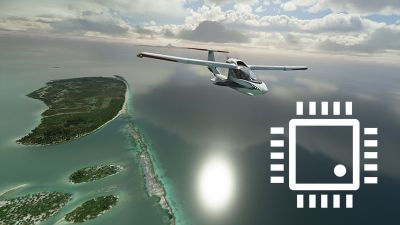
Microsoft Flight Simulator System Requirements: A Complete Guide
Delve into the essential hardware guidelines for achieving fluid performance and mesmerizing visuals in Microsoft Flight Simulator. Learn…

Microsoft Flight Simulator 2024 significantly raises the bar for at-home aviation, with official system requirements spanning entry-level to ultra-fidelity tiers. Performance hinges on balancing CPU, GPU, and RAM, alongside robust bandwidth for streaming real-time data. Notable advancements include improved weather rendering, detailed aircraft modeling, and enhanced photogrammetry, all demanding modern hardware to maintain fluid frame rates and immersive, high-resolution visuals.
Microsoft Flight Simulator 2024 continues to push the limits of realism and immersion, offering improved weather systems, enhanced aircraft detailing, and breathtaking global scenery. As many pilots already know, performance depends heavily on your computer hardware. Below, I’ll explore the official system requirements, provide context for each tier, and share insights on what you need for the best performance.
Every aspect of the simulator is resource-intensive. Weather patterns and atmospheric effects run extensive calculations on your CPU, while the GPU handles visuals such as terrain, clouds, and aircraft textures at ever-increasing resolutions. Meanwhile, system memory (RAM) ensures the software can efficiently process all those real-time elements in tandem. A robust internet connection further supplies live data for scenery, traffic, and weather updates. As a flight simmer, you’ll want balanced hardware to prevent bottlenecks in your virtual cockpit.
Processors: AMD Ryzen 5 2600X or Intel Core i7-6800K
Graphics: AMD Radeon RX 5700 or NVIDIA GeForce GTX 970
RAM: 16 GB
VRAM: 4 GB
Storage: 50 GB HDD or SSD
Bandwidth: 10 Mbps
Operating System: Windows 10 (64-bit)
This tier is designed to get you into the air but be prepared for some concessions. Expect 1080p or lower resolutions, 30 FPS on reduced settings, and fairly moderate detail in high-traffic or weather-heavy areas. If you’re patient around large airports and are not overly concerned about ultra-high texture fidelity, this is enough to start your journey.
Processors: AMD Ryzen 7 2700X or Intel Core i7-10700K
Graphics: AMD Radeon RX 5700 XT or NVIDIA GeForce RTX 2080
RAM: 32 GB
VRAM: 8 GB
Storage: 50 GB (SSD strongly recommended)
Bandwidth: 50 Mbps
Operating System: Windows 10 (64-bit)
Stepping up to these specs offers a better overall experience. With eight-core processors and more powerful graphics hardware, you can target higher detail levels and moderate frame rates at 1440p. Doubling your RAM from 16 GB to 32 GB also helps the simulator handle big scenery loads, real-time weather, and any background processes. A faster internet connection (50 Mbps) further ensures that streaming data—like photogrammetry or dynamic weather—remains fluid and visually impressive.
Processors: AMD Ryzen 9 7900X or Intel Core i7-14700K
Graphics: AMD Radeon RX 7900 XT or NVIDIA GeForce RTX 4080
RAM: 64 GB
VRAM: 12 GB
Storage: 50 GB (NVMe SSD preferred)
Bandwidth: 100 Mbps
Operating System: Windows 10 (64-bit)
Enthusiasts eyeing 4K visuals with fully cranked-up detail settings will appreciate this tier. It’s designed to maintain somewhere in the 40 to 50 FPS range, even in busy virtual hubs. The leap to 64 GB of system memory is particularly notable—though the sim might not constantly use all of it, it gives you headroom for add-ons, background applications, and multi-monitor or VR setups.
Unlike older flight simulators that relied on installed scenery alone, Microsoft Flight Simulator 2024 streams up-to-date satellite imagery and real-time meteorological data. Start with at least 10 Mbps to ensure stable world streaming. For those aiming for photorealistic detail at higher altitudes and big city flyovers, moving up to 50 Mbps or even 100 Mbps is crucial.
Windows 10 64-bit is mandatory, with DirectX 12 as the required graphics API. Although support for Windows 10 runs through 2025, consider the possibility of upgrading to Windows 11 if you’re planning long-term usage of MSFS 2024 and other modern software—especially if you want ongoing security updates and driver optimizations.
CPU vs. GPU: Balance is everything. A fast processor with a lagging video card—or the reverse—may waste potential. It’s wise to select comparable tiers for both components. If you’re angling for the recommended settings, pair a mid- to high-end CPU with at least an equally capable GPU.
RAM Upgrades: If you’re running 16 GB, moving up to 32 GB can be an easy DIY boost. Ensure your motherboard supports the desired RAM speed and capacity. When you jump to the ideal tier, consider 64 GB only if you have the budget and plan on heavy usage or VR.
Storage: Solid-state drives reduce loading times significantly. For especially large photogrammetry or scenery areas, an NVMe drive will help ensure smooth data streaming.
Here are a few highlights that explain the higher system demands:
Once you’ve aligned your hardware with one of these tiers, prepare yourself for dramatic improvements in fluidity and visuals. At higher levels, you can push sliders further without constant stutters, especially near major airports. With the right network conditions, real-time weather transitions and photorealistic cities become nearly seamless. This new version of Microsoft Flight Simulator truly raises the bar for at-home aviation experiences.
Microsoft Flight Simulator 2024 launched on November 19, 2024, on PC, Xbox Series X/S, and Xbox Cloud Gaming. If you’re unsure which spec range best suits your flying habits, consider your favorite aircraft types, typical flight regions, and add-on usage—some are heavier on CPU or RAM, while others lean on GPU performance.
What aspect of your hardware do you plan to upgrade first? Have you already taken the jump to 64 GB of RAM or do you find 32 GB more than enough? Share your thoughts and experiences in the comments below. Let’s talk about how you’re preparing for takeoff in Microsoft Flight Simulator 2024!
Upgrade Microsoft Flight Simulator, FSX, P3D & X-Plane in minutes with our curated file library packed with aircraft, scenery, liveries, and utilities.
Ready to upgrade your hangar?
Browse the free file library
0 comments
Leave a Response